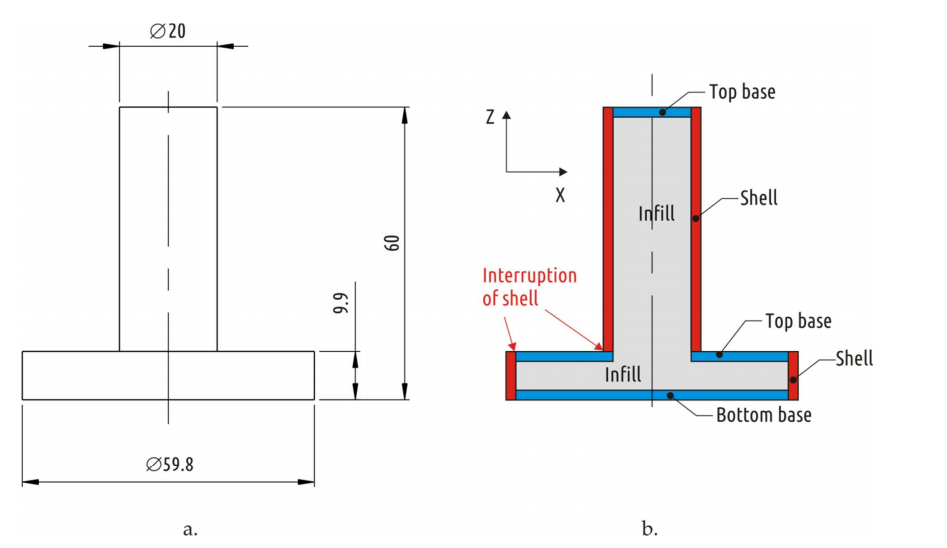In this study, Russian researchers sought to optimize FFF 3D printing parameters further, improving on strength and optimization processes. Their findings were released in the recently published ‘Desktop Fabrication of Strong Poly (Lactic Acid) Parts: FFF Process Parameters Tuning,’ as the team created five different samples from CAD models of parts, 3D printed on an Ultimaker 2. Their initial goal was to increase mechanical properties, allow for predictable quality, and stronger parts overall.
Shape 1 was used to represent FFF 3D printed parts as the geometry suddenly forms a weak spot—with the rest of the samples working as designs to fix the issue in Shape 1:
- Shape 2 was created to increase the strength of weak areas with a new material.
- Shapes 2&3 were meant to increase part strength with FFF 3D printing in mind.
- Shape 4 is the result of numerous design iterations.
- Shape 5 mixes traditional approaches and FFF 3D printing optimization practices.
“Current work shows the effect of tuning the FFF process parameters on the strength of the samples of the same five shapes. Along with ‘coarse’ tuning — altering printing parameters for the whole printing cycle, the “fine” tuning is also studied,” stated the researchers. “In the latter case three parameters are varied during the printing cycle depending on the specific part of the sample being printed. It is shown that for a complex part, only for an optimized geometry (and only for it) significant increment of mechanical performance is achievable by optimization of FFF process parameters.”
For Shape 1, the results were vastly different. Interlayer bonding strength was ‘completely inefficient. Shapes 2-5, there was a significant increase in the part strength.
“It is clearly visible that the air corridors at the boundaries between plastic threads are fragmented and coalesce on the fracture of the Shape 5 sample, printed in mode D,” stated the researchers.
The following parameters remained the same in each case:
- Nozzle diameter (0.6 mm)
- Heated bed temperature (60 °С
- The first layer thickness (0.3 mm)
- The first layer printing speed (25 mm/s).
“The effectiveness of coarse (modes B, C, D) and fine (mode E) FFF tuning for all tested shapes can be evaluated from the Figure 15. Parts of Shape 1, contained critical shell interruption, cannot be strengthened by technological mode optimization as it is shown on the chart (red bars). For all other tested shapes modifying technological modes led to a significant positive effect. Significant increase in strength without loss of product surface and dimensional quality can be achieved by reducing the layer thickness (Shapes 2, 3, 4 and 5, mode C) or by fine tuning the 3D printing parameters (Shape 5, mode E),” concluded the authors.
As 3D printing continues to progress, with multiple offshoots branching off into their own impressive realms from bioprinting to 4D printing, researchers continue to tighten up processes in FFF 3D printing from working with defects to improving speed exponentially. What do you think of this news? Let us know your thoughts! Join the discussion of this and other 3D printing topics at 3DPrintBoard.com.

Destruction of Shape 3 samples printed in mode A [61] (a) and mode B (b). For the mode B sample,
after the test is over, it is still not possible to separate the shaft from the boss with bare hands
Subscribe to Our Email Newsletter
Stay up-to-date on all the latest news from the 3D printing industry and receive information and offers from third party vendors.
Print Services
Upload your 3D Models and get them printed quickly and efficiently.
You May Also Like
The Market and Industry Potential of Multi-Material 3D and 4D Printing in Additive Electronics
Additive manufacturing leverages computer-based software to create components for products by depositing either dielectric or conductive materials, layer by layer, into different geometric shapes. Since its birth in the 1980s,...
3DPOD 262: Bio-inspired Design for AM with Dhruv Bhate, Arizona State University
Dhruv Bhate is an associate professor at Arizona State University. There, he looks at structures, materials, and design. Previously, he worked at PADT as well as in the semiconductor and...
3DPOD 261: Tooling and Cooling for AM with Jason Murphy, NXC MFG
Jason Murphy´s NXC MFG (Next Chapter Manufacturing) is not a generalist service; instead, the company specializes in making tooling. Using LPBF and binder jet, the company produces some of the...
3DPOD 260: John Hart on VulcanForms, MIT, Desktop Metal and More
John Hart is a Professor at MIT; he´s also the director of the Laboratory for Manufacturing and Productivity as well as the director of the Center for Advanced Production Technologies....


































